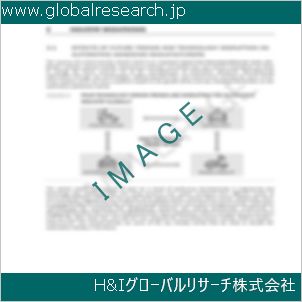Table of Contents
1 Industry Overview of Ironcarbonyl
1.1 Definition and Specifications of Ironcarbonyl
1.1.1 Definition of Ironcarbonyl
1.1.2 Specifications of Ironcarbonyl
1.2 Classification of Ironcarbonyl
1.3 Applications of Ironcarbonyl
1.3.1 Nuclear Application
1.3.2 Non-Nuclear Application
1.4 Industry Chain Structure of Ironcarbonyl
1.5 Industry Overview and Major Regions Status of Ironcarbonyl
1.5.1 Industry Overview of Ironcarbonyl
1.5.2 Global Major Regions Status of Ironcarbonyl
1.6 Industry Policy Analysis of Ironcarbonyl
1.7 Industry News Analysis of Ironcarbonyl
2 Manufacturing Cost Structure Analysis of Ironcarbonyl
2.1 Raw Material Suppliers and Price Analysis of Ironcarbonyl
2.2 Equipment Suppliers and Price Analysis of Ironcarbonyl
2.3 Labor Cost Analysis of Ironcarbonyl
2.4 Other Costs Analysis of Ironcarbonyl
2.5 Manufacturing Cost Structure Analysis of Ironcarbonyl
2.6 Manufacturing Process Analysis of Ironcarbonyl
3 Technical Data and Manufacturing Plants Analysis of Ironcarbonyl
3.1 Capacity and Commercial Production Date of Global Ironcarbonyl Major Manufacturers in 2023
3.2 Manufacturing Plants Distribution of Global Ironcarbonyl Major Manufacturers in 2023
3.3 R&D Status and Technology Source of Global Ironcarbonyl Major Manufacturers in 2023
3.4 Raw Materials Sources Analysis of Global Ironcarbonyl Major Manufacturers in 2023
4 Capacity, Production and Revenue Analysis of Ironcarbonyl by Regions, Types and Manufacturers
4.1 Global Capacity, Production and Revenue of Ironcarbonyl by Regions 2019-2024
4.2 Global and Major Regions Capacity, Production, Revenue and Growth Rate of Ironcarbonyl 2019-2024
4.3 Global Capacity, Production and Revenue of Ironcarbonyl by Types 2019-2024
4.4 Global Capacity, Production and Revenue of Ironcarbonyl by Manufacturers 2019-2024
5 Price, Cost, Gross and Gross Margin Analysis of Ironcarbonyl by Regions, Types and Manufacturers
5.1 Price, Cost, Gross and Gross Margin Analysis of Ironcarbonyl by Regions 2019-2024
5.2 Price, Cost, Gross and Gross Margin Analysis of Ironcarbonyl by Types 2019-2024
5.3 Price, Cost, Gross and Gross Margin Analysis of Ironcarbonyl by Manufacturers 2019-2024
6 Consumption Volume, Consumption Value and Sale Price Analysis of Ironcarbonyl by Regions, Types and Applications
6.1 Global Consumption Volume and Consumption Value of Ironcarbonyl by Regions 2019-2024
6.2 Global and Major Regions Consumption Volume, Consumption Value and Growth Rate of Ironcarbonyl 2019-2024
6.3 Global Consumption Volume and Consumption Value of Ironcarbonyl by Types 2019-2024
6.4 Global Consumption Volume and Consumption Value of Ironcarbonyl by Applications 2019-2024
6.5 Sale Price of Ironcarbonyl by Regions 2019-2024
6.6 Sale Price of Ironcarbonyl by Types 2019-2024
6.7 Sale Price of Ironcarbonyl by Applications 2019-2024
6.8 Market Share Analysis of Ironcarbonyl by Different Sale Price Levels
7 Supply, Import, Export and Consumption Analysis of Ironcarbonyl
7.1 Supply, Consumption and Gap of Ironcarbonyl 2019-2024
7.2 Global Capacity, Production, Price, Cost, Revenue, Supply, Import, Export and Consumption of Ironcarbonyl 2019-2024
7.3 USA Capacity, Production, Price, Cost, Revenue, Supply, Import, Export and Consumption of Ironcarbonyl 2019-2024
7.4 EU Capacity, Production, Price, Cost, Revenue, Supply, Import, Export and Consumption of Ironcarbonyl 2019-2024
7.5 China Capacity, Production, Price, Cost, Revenue, Supply, Import, Export and Consumption of Ironcarbonyl 2019-2024
7.6 Japan Capacity, Production, Price, Cost, Revenue, Supply, Import, Export and Consumption of Ironcarbonyl 2019-2024
8 Major Manufacturers Analysis of Ironcarbonyl
8.1 Manufacturer One
8.1.1 Company Profile
8.1.2 Product Picture and Specifications
8.1.2.1 Type I
8.1.2.2 Type II
8.1.2.3 Type III
8.1.3 Capacity, Production, Price, Cost, Gross and Revenue
8.1.4 Contact Information
8.2 Manufacturer Two
8.2.1 Company Profile
8.2.2 Product Picture and Specifications
8.2.2.1 Type I
8.2.2.2 Type II
8.2.2.3 Type III
8.2.3 Capacity, Production, Price, Cost, Gross and Revenue
8.2.4 Contact Information
8.3 Manufacturer Three
8.3.1 Company Profile
8.3.2 Product Picture and Specifications
8.3.2.1 Type I
8.3.2.2 Type II
8.3.2.3 Type III
8.3.3 Capacity, Production, Price, Cost, Gross and Revenue
8.3.4 Contact Information
8.4 Manufacturer Four
8.4.1 Company Profile
8.4.2 Product Picture and Specifications
8.4.2.1 Type I
8.4.2.2 Type II
8.4.2.3 Type III
8.4.3 Capacity, Production, Price, Cost, Gross and Revenue
8.4.4 Contact Information
8.5 Manufacturer Five
8.5.1 Company Profile
8.5.2 Product Picture and Specifications
8.5.2.1 Type I
8.5.2.2 Type II
8.5.2.3 Type III
8.5.3 Capacity, Production, Price, Cost, Gross and Revenue
8.5.4 Contact Information
…
9 Marketing Trader or Distributor Analysis of Ironcarbonyl
9.1 Marketing Channels Status of Ironcarbonyl
9.2 Traders or Distributors with Contact Information of Ironcarbonyl by Regions
9.3 Ex-work Price, Channel Price and End Buyer Price Analysis of Ironcarbonyl
9.4 Regional Import, Export and Trade Analysis of Ironcarbonyl
10 Industry Chain Analysis of Ironcarbonyl
10.1 Upstream Major Raw Materials Suppliers Analysis of Ironcarbonyl
10.1.1 Major Raw Materials Suppliers with Contact Information Analysis of Ironcarbonyl
10.1.2 Major Raw Materials Suppliers with Supply Volume Analysis of Ironcarbonyl by Regions
10.2 Upstream Major Equipment Suppliers Analysis of Ironcarbonyl
10.2.1 Major Equipment Suppliers with Contact Information Analysis of Ironcarbonyl
10.2.2 Major Equipment Suppliers with Product Pictures Analysis of Ironcarbonyl by Regions
10.3 Downstream Major Consumers Analysis of Ironcarbonyl
10.3.1 Major Consumers with Contact Information Analysis of Ironcarbonyl
10.3.2 Major Consumers with Consumption Volume Analysis of Ironcarbonyl by Regions
10.4 Supply Chain Relationship Analysis of Ironcarbonyl
11 Development Trend of Analysis of Ironcarbonyl
11.1 Capacity, Production and Revenue Forecast of Ironcarbonyl by Regions and Types
11.1.1 Global Capacity, Production and Revenue of Ironcarbonyl by Regions 2024-2029
11.1.2 Global and Major Regions Capacity, Production, Revenue and Growth Rate of Ironcarbonyl 2024-2029
11.1.3 Global Capacity, Production and Revenue of Ironcarbonyl by Types 2024-2029
11.2 Consumption Volume and Consumption Value Forecast of Ironcarbonyl by Regions, Types and Applications
11.2.1 Global Consumption Volume and Consumption Value of Ironcarbonyl by Regions 2024-2029
11.2.2 Global and Major Regions Consumption Volume, Consumption Value and Growth Rate of Ironcarbonyl 2024-2029
11.2.3 Global Consumption Volume and Consumption Value of Ironcarbonyl by Types 2024-2029
11.2.4 Global Consumption Volume and Consumption Value of Ironcarbonyl by Applications 2024-2029
11.3 Supply, Import, Export and Consumption Forecast of Ironcarbonyl
11.3.1 Supply, Consumption and Gap of Ironcarbonyl 2024-2029
11.3.2 Global Capacity, Production, Price, Cost, Revenue, Supply, Import, Export and Consumption of Ironcarbonyl 2024-2029
11.3.3 USA Capacity, Production, Price, Cost, Revenue, Supply, Import, Export and Consumption of Ironcarbonyl 2024-2029
11.3.4 EU Capacity, Production, Price, Cost, Revenue, Supply, Import, Export and Consumption of Ironcarbonyl 2024-2029
11.3.5 China Capacity, Production, Price, Cost, Revenue, Supply, Import, Export and Consumption of Ironcarbonyl 2024-2029
11.3.6 Japan Capacity, Production, Price, Cost, Revenue, Supply, Import, Export and Consumption of Ironcarbonyl 2024-2029
12 New Project Investment Feasibility Analysis of Ironcarbonyl
12.1 New Project SWOT Analysis of Ironcarbonyl
12.2 New Project Investment Feasibility Analysis of Ironcarbonyl
13 Conclusion of the Global Ironcarbonyl (CAS 13463-40-6) Industry 2024 Market Research Report
| ※参考情報 鉄カルボニル(Iron carbonyl)は、化学式 Fe(CO)₅ および Fe₂(CO)₉ のように表される化合物で、鉄と一酸化炭素(CO)から構成されています。この化合物は主に鉄の化合物の一種であり、無機化学の分野で重要な役割を果たしています。鉄カルボニルは、特に合成化学や材料科学の分野で利用されることが多く、その特性や用途に関する理解は非常に重要です。 まず、この化合物の特徴について詳しく見ていきます。鉄カルボニルは、無色から淡黄色の気体または液体であり、かなりの毒性を持っています。触媒としての性質を持ち合わせており、特定の反応において有望な反応剤とされています。鉄カルボニルは、金属心とCO分子との間に強い結合を形成しており、この結合がその特性を決定付けています。鉄の酸化状態は通常0であり、金属-炭素結合を形成することで、金属の電子状態を変化させ、他の化合物と反応することを容易にします。 種類としては、Fe(CO)₅ の他に、Fe₂(CO)₉ や Fe(CO)₄ などの様々な出発物質が存在します。これらは、それぞれ異なる構造や反応性を持っており、研究や実用において異なる利点があります。例えば、Fe₂(CO)₉ は二つの鉄原子が結合した構造を持ち、より複雑な反応を行うことができます。一方、Fe(CO)₅ は比較的簡単な構造であり、合成においては重要な中間体として機能します。 鉄カルボニルの用途は非常に広範囲に及びます。最も広く知られている用途の一つは、触媒としての役割です。特に、炭素と水素の化合物を用いた合成反応において、鉄カルボニルは高い効率を持つ触媒として用いられています。例えば、メタノールの合成や、炭化水素の逆合成において、その特性を活かすことができます。 また、鉄カルボニルはナノ材料の合成にも用いられ、その特性からさまざまな有機・無機ハイブリッド材料の作成に寄与しています。さまざまなサイズや形状の鉄ナノ粒子の合成に利用され、これにより電気触媒や磁性材料の性能向上が図られています。このように、鉄カルボニルを用いたナノテクノロジーは、材料科学の進展に大きく寄与しているのです。 さらに、鉄カルボニルはその毒性ゆえに、環境や健康に関しても注意が必要です。一酸化炭素自体が毒性のある気体であるため、鉄カルボニルを扱う際には適切な取り扱いが求められます。特に、工業的なプロセスでは、作業空間の換気や個人防護具を用いることが重要です。また、廃棄物の処理や環境への影響についても慎重に対処する必要があります。 最近の研究では、鉄カルボニルを用いた新しい合成手法の開発が進められています。特に、グリーンケミストリー(環境に配慮した化学)の観点からも評価されており、持続可能な化学反応プロセスの確立に向けた努力が続けられています。また、機能性材料や新規エネルギー変換デバイスにおける応用も模索されており、未来の化学工業において更なる重要性が期待されています。 このように、鉄カルボニルは多様な特性を持ち、さまざまな分野で利用されている化合物です。その合成や特性の理解は、化学産業や研究の進展に不可欠であり、今後の発展が非常に楽しみです。鉄カルボニルの研究と応用は、化学の未来においてますます興味深い領域となることでしょう。 |
❖ 免責事項 ❖
http://www.globalresearch.jp/disclaimer

-gr.jpg)










